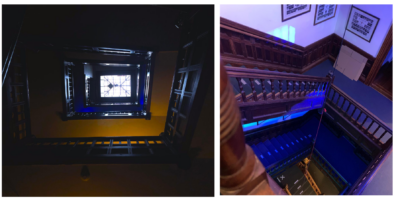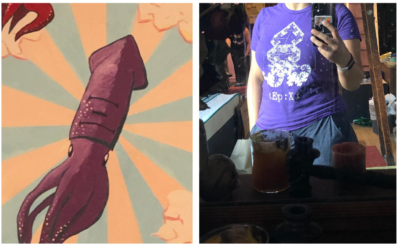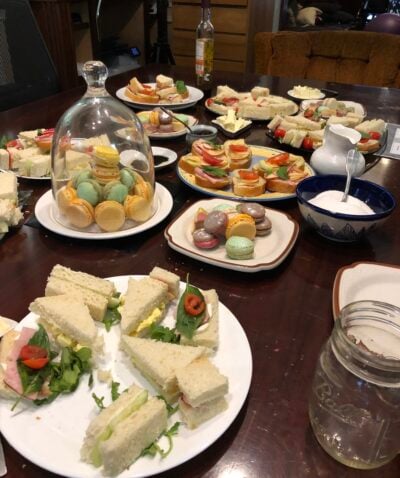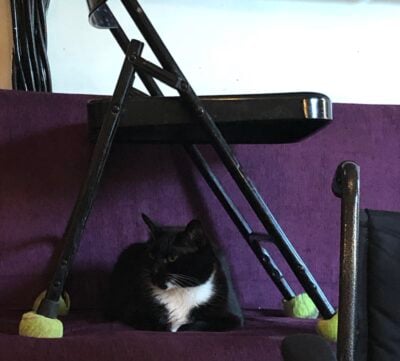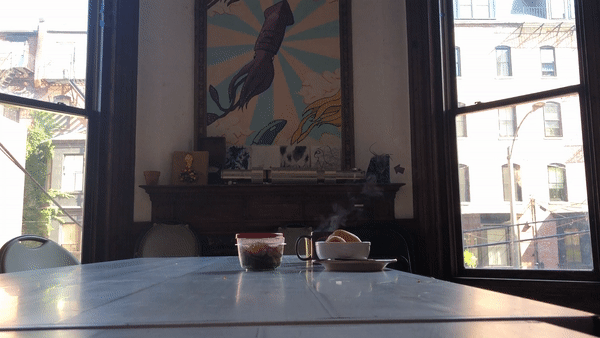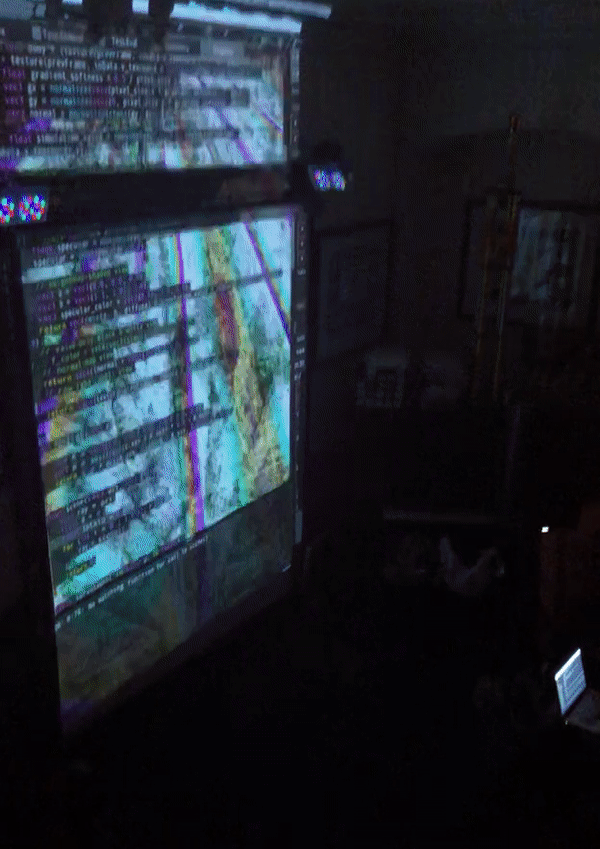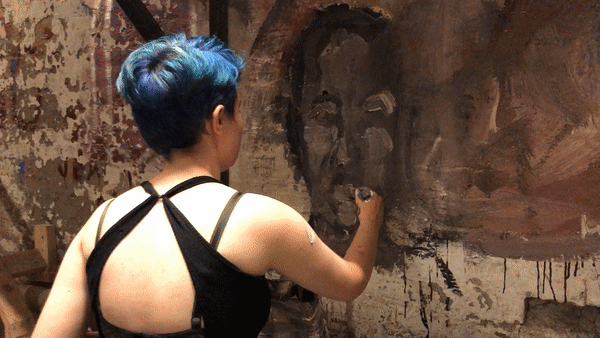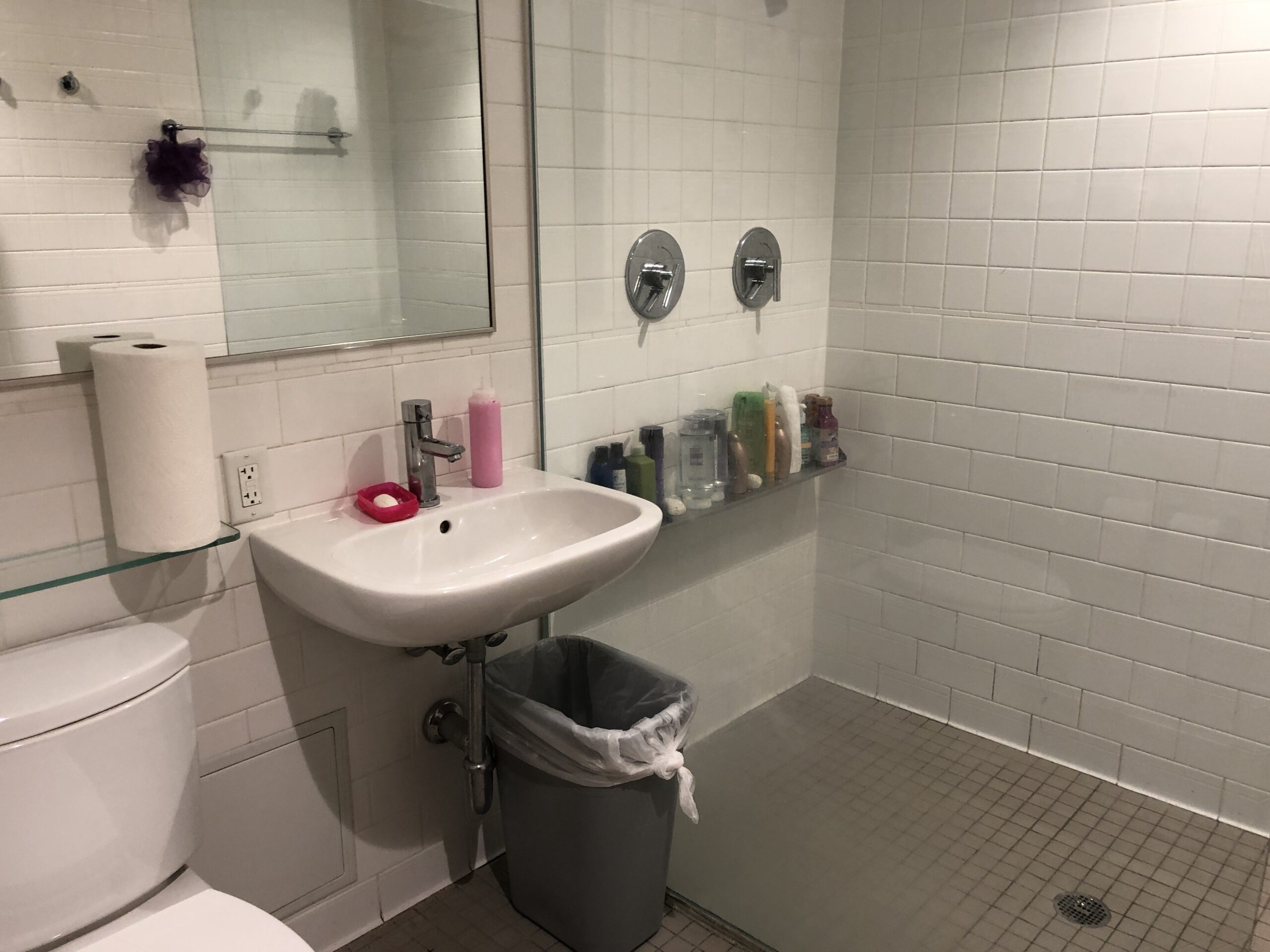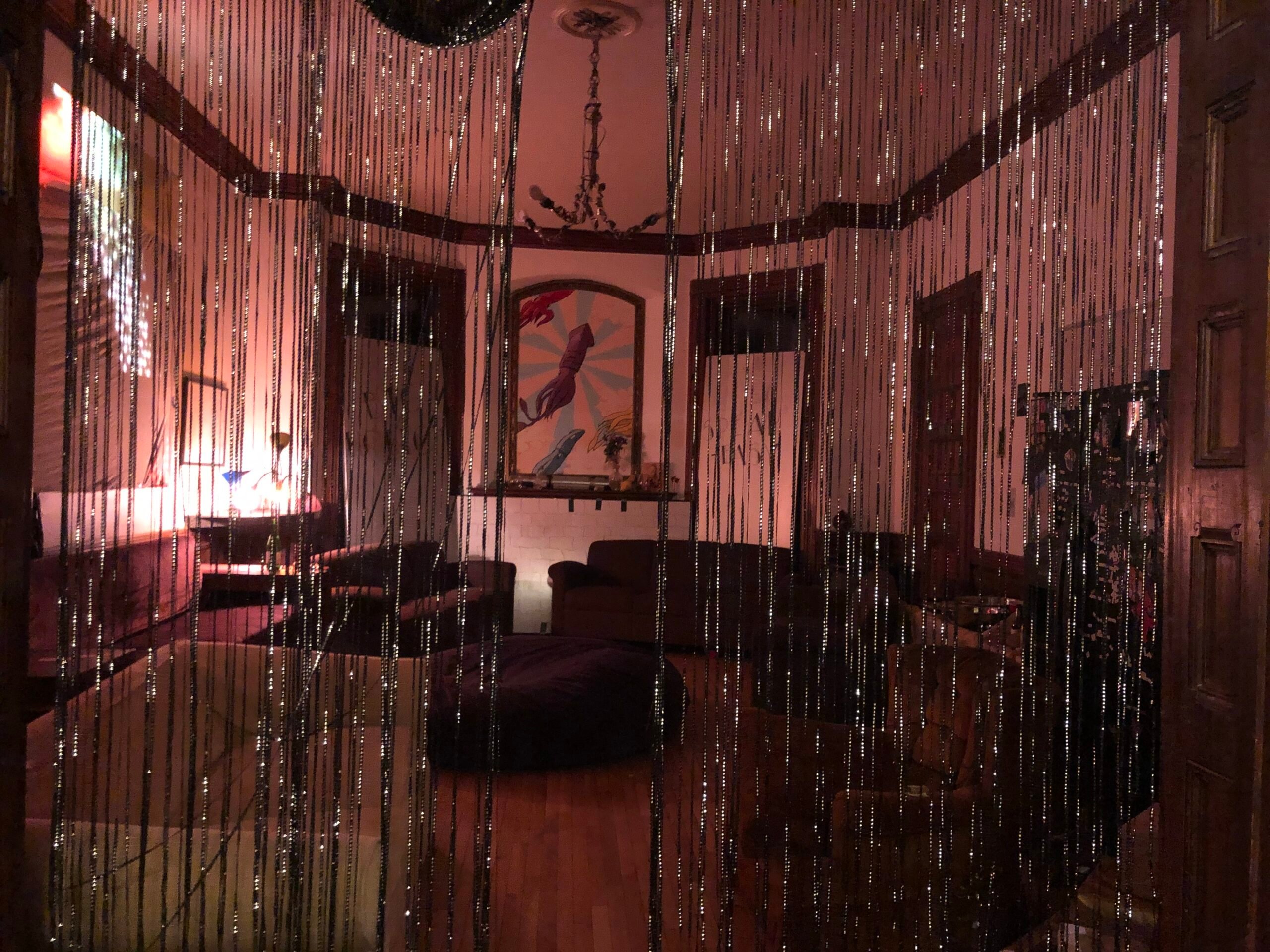
22 Tales from tEp by Kathleen E. '23
strange sights and stranger delights
I stayed in Boston last summer. For MIT students who stay in the Boston area over the summer, there are three main housing options (listed below in order of increasing personal preference):
- Stay in a dorm on MIT’s campus. Last summer, MIT opened only East Campus (EC) and Burton Conner House (BC) for summer rent (the other dorms were either closed or being used by people in MIT’s various summer programs for high school students). This is the worst option, in my opinion, because both EC and BC didn’t have air conditioning in individual rooms and the monthly rent was high (relative to the other options).
- Sublet an apartment. Lots of people sign year-long leases on apartments (including those in MIT’s graduate dormitories) in Boston/Cambridge, but want to live elsewhere in the summer. These people then sublet their space to students like us! These options can have nicer facilities (read: air conditioning) than the dorms.
- Rent a room in an MIT FSILG. Most off-campus FSILGs (Fraternities, Sororities, and Independent Living Groups) rent their available rooms to non-member summer residents. This had the most appeal to me because (depending on the FSILG) the facilities were better and the rent was lower than the dorms, while maintaining the style of living with a bunch of other college students. I also valued the chance to try living off-campus in a new neighborhood. Moreover, it would be an opportunity to get to know an FSILG community through casual day-to-day events, as opposed to scheduled social events that happen during the year.
In making my summer housing decision, I purposefully chose to switch things up from my academic-year housing. I did so with full acknowledgement that I might end up disliking it. In the end, it was an imperfect fit but a fantastic summer. I’m so glad I took the risk.
I was in search of a summer rich in feelings, experiences, ideas, and people. I found overwhelming amounts of those things at Tau Epsilon Phi (abbreviated as tEp), a co-ed fraternity located on Commonwealth Avenue in Back Bay. tEp was an incredibly vibrant and accepting place. It was also incredibly bizarre. The strangest points felt like dream. Every day made me feel like I was at a college-student summer camp.
For this post, I’ve written up 22 anecdotes from my time at tEp. (Read to the bottom for my concerns about how COVID-19 will affect FSILGs and my support for making gender-inclusive societies the norm instead of gender-exclusive ones.)
[1] Twenty-two
You might be wondering, why 22? All I can really say is that 22 is a recurring theme at tEp. For example, meal times. Summer residents contributed to a rotating cook-and-clean team for group dinners and brunches. Dinner was served at 7:22 PM and brunch at 11:22 AM. Once a meal was cooked and assembled on the dining room table, it was convention for the cook team to gather at the base of the stairwell, and scream DIIIINNNERRR (or BRUUUNCCHHHH) in unison up through the five floors of the house. The call ensured that any soul too deep in their work (or in the case of brunch, too deeply asleep in bed) would be reminded that it was time to eat. Various other tEp events, like our weekly socials, would also occur at 22 minutes past the hour.
[2] Thirty-three purple squids
Take a look at the sky, what do you see? A purple haze, perhaps? A giant flying squid? -tEp email
Two holy symbols in the house were squids and the color purple.01 Purple is one of Tau Epsilon Phi National's official colors Outside the house, the tEp flag flown from the house was purple. The only purple-leaved tree on our block of Commonwealth Avenue was located on the front “lawn”.02 More like a 10x10 ft patch of grass Inside the house, on the wall above the head of the dining room table, there was a mural of giant purple squid, which presided over every meal. The walls of my room03 See the photo in anecdote 3 were also purple. The tEp shirts were purple and many had squids on them. I was given one with a squid made from fractals!
There were 33 other summer residents at tEp. The first house dinner was an exciting blur of new names and faces of students from so many different schools. It was so cool to live alongside students from Wellesley College, Northeastern University, Boston University, Olin College of Engineering, Berklee College of Music, and UMass Amherst. I loved that they were all passionate about so many different things – it was a refreshing shift from the typical foci of the MIT community (but my fellow MIT students were also a delight to get to know better).
[3] Sleeping from the ceiling
Almost all of the beds at tEp04 The fifth-floor singles were too short and thus had regular beds that sat on the floor. were mounted to the ceiling. The ceiling-mounted beds meant that there was more than enough space on the floor for other furnishings, like desks and couches – though the house also had ceiling-mounted versions of those! For example, my room had four beds and a couch, all hanging from the ceiling.
I used a ladder to get in and out of bed. Rather than the conventional four-legs-on-the-floor, my sleeping body was suspended by four metal rods, each at the top attached to the ceiling and at the bottom attached to a mattress-sized piece of wood. My friends always asked if the bed rocked, or moved, at all. The answer is no, it did not. The supports kept it entirely still.
Some of the hanging beds had railings. As you can see in the photo below, mine was not one of them. Luckily, I never dropped anything (including my own body) off the sides.
The tEps liked to remind us that the beds were constrained by volume, not weight. Eleven people could fit on a bed, but not twelve, because there was no space – not because the supports would fail. This was comforting knowledge. Still, I did have some pretty intense dreams over the summer and I blame it on my subconscious being anxious from my sleeping on a bed hanging from the ceiling.
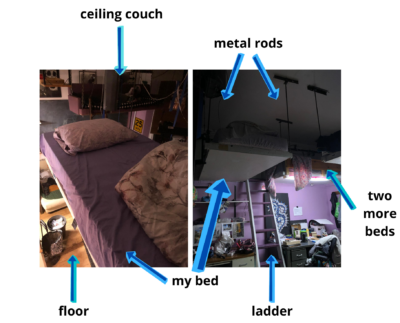
[left] a view of my bed from my ladder, plus a slight view of the hanging couch behind it, [right] a view from the floor… excuse the messiness, these were taken right after move-in
[4] Invisible injury
Despite all the craziness at tEp, I only got hurt once and it was my own fault.
I was climbing the ladder to my bed and was only about three rungs from the bottom when I lost my footing. I fell to the left, slamming my thigh into the the sharp corner of the desk next to the ladder. This resulted in a two-inch bleeding wound.
My three roommates were either asleep or facing away from me with headphones on, so no one heard or saw me get injured. I laid on the floor for a minute, clutching my leg and saying various expletives, until I felt my hand get wet with blood and stood up to go get cleaned up.
I found this kind of ironic. In the move from my dorm to tEp, I had gone from living in a single to a quad. I was worried about how I’d handle the decreased privacy that comes from going from zero roommates to three. But, in the one vulnerable moment where I could have used some attention, my roommates were all lost in their own little worlds.
[5] Afternoon tea
One of my three roommates, Dayna, wanted to put on a tea party for the house. I wasn’t expecting much aside from a few pots of hot water with some tea bags from the house’s communal tea drawer.
When I arrived in the Front Room to find a traditional English afternoon tea, I was blown away. In addition to tea, Dayna and her friends had made a huge variety of amazing French macaroons, finger sandwiches, and open sandwiches. The table was crowded with plate after plate of colorful, delicate food. It was standard operating procedure at tEp to go above and beyond and this particular afternoon stands out in my mind as a beautiful example of that.
[6] House food
Dayna’s tea party, along with every single house dinner and brunch, was facilitated by the fully-stocked industrial kitchen in the basement of tEp.
The kitchen had everything and was meticulously organized. Next to a wall of spices was a drawer of every cooking utensil imaginable.05 My favorite were the tongs! They're so useful for so many things. Hanging from the ceiling and walls were countless pots and pans, from which I had my first experience cooking with a cast iron pan and a 5-gallon stock pot. The fridges, freezers, and pantries were restocked each week with a massive food order from Sysco. The range of ingredients and groceries we were able to consume in a week was impressive – whether it was fajita seasoning, kale, breakfast sausages, greek yogurt, or frozen fruit, a meal would be made and devoured.
I signed up to be on the cook team for Sunday’s brunch. I also occasionally helped with dinner shifts. We’d begin our cooking around two hours before any given meal. It can take a long time to cook enough food for 30 people! The meal would begin with planning a menu (which always included dessert!) and dividing up the dishes between cooks. We made sure each menu included food that aligned with people’s dietary restrictions. After prepping ingredients, we began cooking, often with music blasting from the kitchen speakers. Shortly before the meal was served, someone would go upstairs and set out plates, bowls, cups, and utensils at the start of the dining room table, where people would line up to serve themselves. We’d then bring the food upstairs and use a dry erase marker to write directly on the metal table next to each dish what each dish was and what ingredients it had.
House food was a wholesome part of my daily routine that I didn’t know I wanted until I had it. Seeing many of the same faces day after day gathered around for a shared meal made tEp feel like a family. I also loved trying (in terms of both cooking and eating) tons of new recipes.
[7] Individual cooking, industrial kitchen
All of the kitchen utilities and Sysco ingredients were also available for residents’ individual use. I took advantage of this by baking lots of desserts and cooking breakfast as often as possible. One evening, I invited a friend over from a frat down the street (PKT) and we made chocolate chip cookies from scratch. On mornings when I managed to wake up early, I’d make myself breakfast sandwiches or pancakes. On mornings when I was running late, I’d just cut some fruit and have it with greek yogurt and nuts. Either way, the industrial kitchen was so useful and I miss not having to worry much about buying groceries. I did buy some fruit each week, at a low-cost produce market in the North End called Haymarket, since tEp didn’t order non-frozen fruit from Sysco.
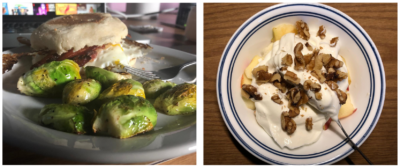
[left] breakfast sandwich (eggs and bacon, it looks like) with Brussels sprouts, [right] sliced honeycrisp apple with greek yogurt and walnuts
[8] Echoes, echoes
On July 4, I went to the roof of tEp to watch the fireworks over the Charles River. It was breathtaking. Each firework explosion briefly illuminated the MIT skyline. There are some moments when the feeling of being at MIT gets un-normalized, and my heart beats all fast, and I get the flutters I got when I first arrived on campus. This was one of them.
The sonic boom from each firework echoed loudly off the skyscrapers behind us. I actually turned around a few times to double check that there wasn’t a second fireworks show happening over Boston.
[9] House gato
Pets are welcome at tEp. One resident had snails and another had a snake. Here another resident’s cat. His name is Gato (which is Spanish for cat). Gato loved scaring me by coming into my room when I wasn’t paying attention and knocking into stuff.
[10] Me vs. Gato
Something I’m a bit sad to admit is that I’m not the fondest of cats. I wish I were; it would be fitting because I was born in the Year of the Cat in the Vietnamese zodiac (I’m Vietnamese). I just get nervous that they’ll scratch me.
Gato wasn’t too scary, but he sure liked to get in my food if I wasn’t attending to it. One morning, I had just finished setting out my breakfast on the dining room table when I realized I needed to run upstairs to grab something. It was a very early morning, so there wasn’t anyone nearby to ask for help watching my food and protecting it from Gato’s paws. I turned on my phone camera, aimed it at my food, and ran upstairs as fast as possible. When I got back, I checked the video and Gato was no where to be seen. However, I did get an incredibly peaceful video. Thanks, Gato.
[11] Livecoding GLSL
An artist from Carnegie Mellon named Char Stiles visited tEp for a few days. Over the weekend she gave the house a three-hour workshop on livecoding shaders. We all learned how to use GLSL (the OpenGL Shading Language) to write programs that ran directly on our computer’s GPU. They were “livecoded” in the sense that any changes we made to our code were shown instanteously in real-time.
As someone who loves art and also coding, this unexpected opportunity to learn GLSL right in my own living space was a dream come true. It was so fun making shaders with the other residents, who impressed me with their creativity. We all demoed what we made using the projector in the Front Room. Later that night after dinner we had an “Algorave” where Char programmed realtime graphics to music.
[12] Festival
In early August, tEp hosted an event called Festival. Throughout the house, around 20 different artistic projects and performances were on display. People from all sorts of creative backgrounds visited to enjoy and engage with us. We had murals, live music composition, stroboscopes, and much more.
I and two other residents led a performance art piece called “Antagonistic Creation” in the basement. We used three different areas of the wall as our canvases. Guests were allowed into the space a few at a time, given paint and brushes/rollers, and allowed to interfere with our painting however they wanted. Our work was painted over, we were painted on, and I even had my brush stolen, after which I resorted to painting with my hands.
[13] Pianola
tEp had a pianola in the Center Room. A pianola is a self-playing piano! Unfortunately I don’t have a video of the pianola at tEp but you can watch a nearly identical one being demoed here.
To use it, a roll of music programmed on perforated paper is inserted into to the pianola while a person pushes the foot pedals. The keys of the piano would move on their own and music would just play! It was as if a ghost was playing. The pianola can also be played as a regular piano. Program or person, the music swelled through the house, filling the stairwell with music.
[14] Boomeranging mini-fridge
At the end of the Spring semester, tons of graduating seniors send out emails advertising that they’re either selling or giving away their belongings. I mostly ignored these emails, except one from a resident of Baker House advertising a free mini-fridge. I responded quickly and managed to snag it!
To transport it from Baker House (where the original owner lived) across the river to tEp, I recruited help from two friends to load it into a cart, push it the 1.1 miles to tEp, and then get it out of the cart and up the stairs to my room on the second floor. I did most of the pushing; the help was most needed in carrying the mini-fridge up the stairs.
I mainly used my mini-fridge it to refrigerate the produce I bought at Haymarket (a low-cost produce market in the North End). This meant I could have my favorite fruits (tomatoes and mangos) and other produce perfectly chilled at almost any time!
I found out sometime in the middle of the summer that before the Baker House resident owned the mini-fridge, it had belonged to a tEp member living across the hall from me. We both found it amusing that the mini-fridge had made its way back across the river.
[15] Pandan ice cream
I also used the freezer compartment of mini-fridge to store a pint of pandan-flavored ice cream (you can see it in the previous photo).
(If you’re not familiar with Southeast Asian cuisine, you probably haven’t heard of pandan. Pandan is a tropical plant that is used to give foods a sweet aroma and bright green color. I grew up eating various Vietnamese cakes and jellies flavored with pandan.)
J. P. Licks, one of the most popular ice cream stores in Boston, has monthly specialty flavors. For the month of June, they chose to do a Southeast-Asian-themed array of flavors, offering ube (purple yam), peanut (Thai-inspired), and PANDAN! I had never, ever imagined having pandan-flavored ice cream. When I sampled it at the counter, I nearly started crying. It was so good and reminded me so much of childhood. I went back to J. P. Licks a ridiculous number of times over that June. I visited the locations in Back Bay (closest to tEp), Beacon Hill (east of tEp), and Harvard Square.
I decided during my first visit that I absolutely needed to share the pandan ice cream experience with my mom (she’s Vietnamese). I bought a pint of pandan from the Beacon Hill J. P. Licks and stored it in my freezer for about a month until my family visited me in Boston in early July. I took them to the tEp roof and shared the pint as we looked out over Boston.

[left] photo from J. P. Lick’s facebook page announcing the ube, pandan, and peanut flavors! [center] my own cone with ube and pandan [right] the pint after my family ate it
[16] Roof adventures
Getting to the roof of tEp took some effort. I would have to take the stairs to the fifth floor, go into the study room, climb out of a window to get onto a balcony, and then take another set of stairs. Once I was finally on the roof, I could enjoy the direct sunlight (or moonlight) and the spectacular view of Cambridge.
The roof was an odd place. There was a bathtub, which I never saw anyone use, but was supposedly fully operational. There were also several different lawn chairs which were nice to sit on during our July 4th celebrations.
I liked going to the roof to eat. Once while walking down Commonwealth Avenue, a friend and I got stopped by a random man carrying a huge brown paper bag. He said was a food delivery driver and had picked up the wrong order. He wanted to give it to us. We cautiously accepted it and then spent some time back at tEp wondering if it was safe to eat. In the end, we decided to just go for it. There were seven different containers of food, including various rices and curries. That was probably the best meal I had on the roof.
[17] Gossip and slander
There was a house mailing list called “gossip and slander” dedicated to sharing the best quotes heard around the house. Each email had the speaker as the subject line and their quote in the message body. One highlight was “Treat your main bitch like lettuce,” which I’m still trying to understand (but I suspect it might be truly prime advice).
[18] Lemonade and squids
tEp had two social events each week. One was Lemonade, at 9:22 PM on Monday nights, and the other was Squids, usually at 10:22 PM on Thursday nights.
For Lemonade, there was actual lemonade! It was made in a 5 gallon stock pot using a standard recipe of water, bottled lemon juice, and sugar. Sometimes people experimented with other ingredients. These experimental lemonades were occasionally successful but more often (in my opinion) just kind of strange. There would also be bread, cheese, and fruit. Everything was served downstairs in the dining room. I got the chance to catch up with other residents. Sometimes I invited some friends from down the street at PKT. Lemonade was something to always look forward to on Mondays.
For Squids, there were no actual squids. Except us, metaphorically. This was a large social that would be hosted in one of the large social rooms in the house (mine was part of this rotation). There was alcohol, snacks, and a lot of guests. It was a chance to get the weekend started a bit early and meet people from outside of tEp.
[19] Poop closet
Thankfully, rather than this being what it might sound like, the Poop Closet was just a closet in the basement which contained all of our cleaning supplies. There was disinfectant, latex gloves, paper towels, toilet paper, garbage bags, hand soap refills, and much more. Everyone in the house had a weekly work assignment that contributed to keeping the house clean.
My work assignment was cleaning the bathroom next to my room, which I actually liked because I got to directly reap the benefit of my labor. Our bathroom was pretty standard except that the shower had two shower heads! I found that pretty cool.
[20] Dining room lights
In the dining room, one wall was nearly covered with led panels. The panels were programmable and there was a computer in the corner of the dining room for that purpose. The panels were collectively called “tepilepsy” and were best viewed from a distance. I found it funny that to maximize my enjoyment of tepilepsy, I had to stand back really far and squint to blur my vision. Other members of the house could just take off their glasses and tepilepsy would be beautiful. Also, I didn’t mean for this to be a humble brag about my vision, but here we are.
[21] What is this, a crossover episode?
In early February 2020, tEp had a party that was well-attended by another living group on campus: New House 4. During the fall semester, I spent nearly half my time in New House (especially House 4), hanging out with friends and psetting. My Harvard friends also came to this party. It was so weird, in a really pleasant way, to see a ton of familiar faces from New House at tEp. It definitely felt like a “crossover episode” – it was fascinating to see the people from a few disparate parts of my life socializing and becoming friends. That night, I visited my old room and saw that all of the stuff I had written on the chalk board above my old desk (to do lists, motivational quotes, weird art) had been perfectly preserved. As I stood there, looking at it and revisiting the mental space of the very different person I was around six months earlier, it felt like an eternity had passed since I called tEp home.
[22] Bid
At the end of the summer, the tEp residents surprised me by giving me a bid. This is typically the first step in becoming an actual member of a fraternity. After getting a bid, one has to pledge, then be initiated.
I was very happy to get the bid. In the end however, I ended up not initiating. One requirement for initiating was that you had to live at tEp. I wasn’t ready to live off-campus; I had too many friends I lived one minute away from on dorm row and I wasn’t ready to give that up. I also ran into some concerns about if I would be able to contribute meaningfully to the house during the academic year. I was pretty hosed my sophomore year and I probably wouldn’t have kept up with the necessary contributions to doing house food or work assignments.
Moving out was bittersweet.
If you read this far down, you probably got a good feel for what it was like to be an MIT student who spent a summer at tEp. While I didn’t decide to live there full-time, I found it to be a wonderful community and always looked forward to my visits.
COVID-19: This fall,06 Fall 2020 MIT FSILGs will not be able to do traditional recruitment. If things don’t return to “normal” soon, I worry that many of the cultural traditions of each FSILG (as well as on-campus dorm communities) will fade as senior members graduate and lose opportunities to share them with junior members. This worry is especially strong for places like tEp, where so much culture gets packed into just a few members.
I hope we get COVID-19 under control and can return to “normal MIT” as soon as possible. In the meantime, I hope that by writing (very detailed and long) blogs, I can help preserve everything I know about the culture of the spaces I love at MIT. I hope that other students can also find the time and energy to create written records of their experiences and cultural traditions, so that if we can’t impart them directly, future generations of students can still have a basis on which to reconstruct them.
Inclusivity: tEp is also special to me because people of all gender identities can become full members with residential privileges and voting rights. I hope that in the future, gender-inclusive societies replace single-gender organizations as the norm in the MIT FSILGs. I recognize that gender-exclusive organizations can have a valuable purpose,07 Especially for marginalized groups! so I don’t think they should be abolished. However, I think that gender ought not to be a major determining factor in something as important as what living groups are accessible to students.
This is a controversial opinion (especially among male students in gender-exclusive fraternities). I’m not surprised – after all, MIT still has not achieved sex parity in its student population. The longstanding oppression and exclusion of women in academic spaces, especially technical ones, lives on today at MIT and across the globe. Over the last 60 years, undergraduate women at MIT have gone from 3% of the student population to the 47% we are now, but that’s not enough. Women continue to be much more underrepresented in graduate student and professor populations. Over the last 60 years, women at MIT been given greater access to living on campus – before the establishment of McCormick Hall in 1963, there were only 50 beds on campus for women. Now women can reside in any dormitory. But that’s not enough.
It’s been a long road for someone like me to get my foot in the door at a place like MIT. There are many more doors women continue to face and that I hope to see knocked down. I love tEp for leading the charge.
- Purple is one of Tau Epsilon Phi National's official colors back to text ↑
- More like a 10x10 ft patch of grass back to text ↑
- See the photo in anecdote 3 back to text ↑
- The fifth-floor singles were too short and thus had regular beds that sat on the floor. back to text ↑
- My favorite were the tongs! They're so useful for so many things. back to text ↑
- Fall 2020 back to text ↑
- Especially for marginalized groups! back to text ↑

